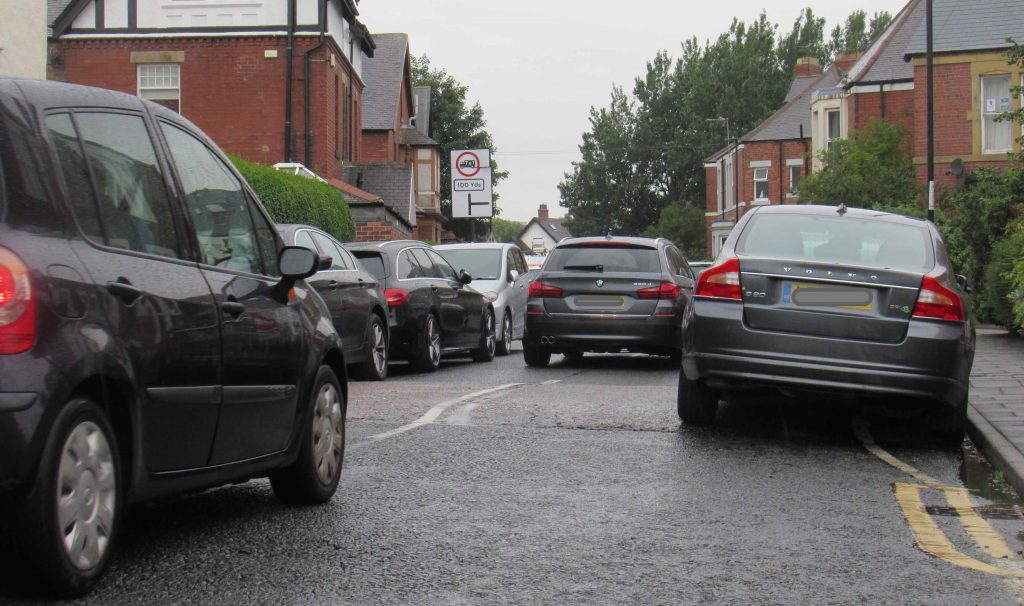
Stoneyhurst Road 30 July 2020, just before 9am.
Newcastle City Council has now confirmed that legal orders to close local bridges to vehicle traffic will be in place by Thursday 13 August. This is to prevent “inappropriate levels of traffic for small structures, using the bridges as a shortcut through residential streets.”
As with any traffic-related changes these proposals have generated a lot of debate in Gosforth. To help ensure this debate is an informed one we published a Frequently Asked Questions (FAQ) Enabling Safe Walking and Cycling via Local Bridges explaining likely benefits, possible issues and how residents will be able to have a say on the proposals.
Legal orders to close Salters Bridge, Castle Farm Rd (Dene Bridge), Haldane Bridge, Argyle St Bridge and Stoneyhurst Bridge to traffic will be in place from 13 August. This is to reduce traffic and encourage more walking and cycling. Read more at https://t.co/QTfnJWBXHw. pic.twitter.com/Pz7jzN57hd
— NewcastleCityCouncil (@NewcastleCC) August 4, 2020
Since then, we’ve become aware of some further concerns, relating to the consultation process and specifically to the area around Stoneyhurst Road Metro bridge. Where there are legitimate issues it is important that these are raised, but also where residents’ concerns are likely to be unfounded it is important that residents have the necessary information to be able to make this judgement.
This blog is to look at some of those concerns. Where we have included quotes about concerns, these are from comments or email correspondence sent to SPACE for Gosforth.
Summary
- There’s no justification for the suggestion that 20mph “single track” roads leading to Station Road are dangerous for people who are driving, or that the junctions onto Station Road are in any way different or more dangerous than other similar junctions.
- Challenges faced by residents in snowy or icy conditions will be no worse than on many other local roads. Residents who can’t avoid travelling and have to use a car still have two relatively level entry/exit routes via Balmoral Terrace and Windsor Terrace.
- Traffic levels should reduce overall on Audley Road, Sandringham Road, Windsor Terrace, Balmoral Terrace and other local streets. This should improve safety for people who do walk or cycle, including when the roads are icy.
- Generally the change will result in opportunities for residents to save money, as walking or cycling are much cheaper than driving, with a minimal impact on driving times or distances other than for very short local journeys.
- Council comms confirm that vehicle capacity at Haddricks Mill has been increased.
- The Council, and Government, are acting on a democratic mandate to make streets safer for walking and cycling. These changes have a substantial potential to help improve people’s health and wellbeing.
Our thinking & analysis to support these summary statements is below.
In our previous FAQ blog Enabling Safe Walking and Cycling via Local Bridges, we also confirmed that:
- Based on experience when Killingworth Road was closed, we don’t expect any substantial increase in traffic on Station Road. Pollution levels measured at the bottom of Station Road actually improved.
- Emergency Services have confirmed they have no issue with the proposal.
- The consultation approach will be more effective by allowing residents to “try before they buy”.
| You can comment and provide feedback on the Council’s proposals on the Council’s Commonplace web site. The web address is https://safenewcastlebridges.commonplace.is |
Update 9/9/2020: The Council have also published a response to Frequently Asked Questions on its SafeNewcastleBridges website.
Concern 1: It isn’t safe to exit by car onto Station Road
“the exits from Sandringham, Audley or Windsor are not the safest ways to get out of the area as they are single track.”
We can find absolutely no justification for the statement that single track roads with a 20mph speed limit, such as those described, present any substantive safety risk to anyone travelling by car. Vision Zero guidelines suggest that cars should be limited to 70kmph/43mph where there is a possibility of a frontal impact between cars, so 20mph is certainly safe enough.
Safety for people walking and cycling (vulnerable road users) is affected by speed and volume of traffic including on Stoneyhurst Road. Safety should be improved on these local streets because of the reduction in traffic levels (see below). As we explained in our blog Enabling Safe Walking and Cycling via Local Bridges, this should help enable more people to walk or cycle local journeys.
The junctions with Station Road are little different to many other similar junctions, and may actually be safer due to relatively tight corners that require drivers to slow down before turning.
If this does become an issue (which we don’t think it will), one option might be to reset the speed limit for that section of Station Road to 20mph. This would also make it safer for people walking or cycling on Station Road, and would be likely to reduce pollution levels as a vehicle accelerating to 20mph uses less fuel than one accelerating to 30mph. We hope this might be considered as part of the consultation review.
Concern 2: Dene Crescent cannot be used in winter
“the exit onto Haddrick’s Mill Rd from Dene Crescent is lethal in winter even with the grit box”
To look at this we have assessed whether the proposal will lead to more or fewer people using Dene Crescent by car in wintery conditions, and other options for exiting the estate if Dene Crescent is not usable.
The Highways Code Rule 228 is very clear that you should not drive in icy or snowy weather unless your journey is essential. If your journey is essential and you have no choice but to drive, you should “drive with care, even if the roads have been treated.”

This should mean the volume of traffic if icy or snowy should be much lower than on a normal day, especially now many of us are able to work from home. That will be true whether this proposal is implemented or not.
Closing Stoneyhurst Road bridge to motor traffic should also reduce the volume of traffic, as vehicles that would have used Stoneyhurst Road bridge to get to Dene Crescent, possibly by non-local drivers who would be less aware of the dangers, can no longer do so.
Having fewer vehicles using Dene Crescent in winter is a safety benefit in itself. Dene Crescent is also one of only a few residential streets that are on the Council’s published gritting route. Even if that is not sufficient, residents who need to make essential journeys by car have other options and contrary to some claims we have seen, no one is being “forced” to use Dene Crescent.
GoogleMaps states that Balmoral Terrace drops 4m over a distance of about 350m, which is a gradient of not much more than 1%, which is likely to be less steep than the transverse slope that is required on roads to allow drainage. It is also likely to be less than the gradient of the speed bumps on Stoneyhurst Road. The gradient on Windsor Terrace is not much greater.
For residents living on Sandringham Road and Audley Road, which according to GoogleMaps have average gradients of about 2.8%, the main challenge will be exiting those roads especially if facing uphill. That would be no different from now though, and would be unaffected by the proposed change.
By comparison nearby Keyes Gardens has a gradient of 3.6%, Hunter’s Road next to Haddricks Mill is close to 7% and many other streets bordering Jesmond Dene are steeper than this.
That’s not to say that driving in winter will be all plain sailing, only that the challenges faced by residents will be no worse than on many other local roads, and that an overall reduction in traffic levels should improve safety for people who do walk or cycle.
Concern 3: “more traffic using Audley, Sandringham, Windsor & Balmoral“
In our FAQ, question 6 we provided evidence to show that there was unlikely to be any substantial impact to local main roads as a result of the bridge closures. This concern is a bit different in that it relates to local streets.
We shared the picture below in our FAQ blog, of nine locations in Newcastle where similar approaches have been taken, and none of these areas are prone to “chaos” or “road rage” as some have suggested will happen on Stoneyhurst Road, in fact quite the opposite. All are very quiet, pleasant streets.
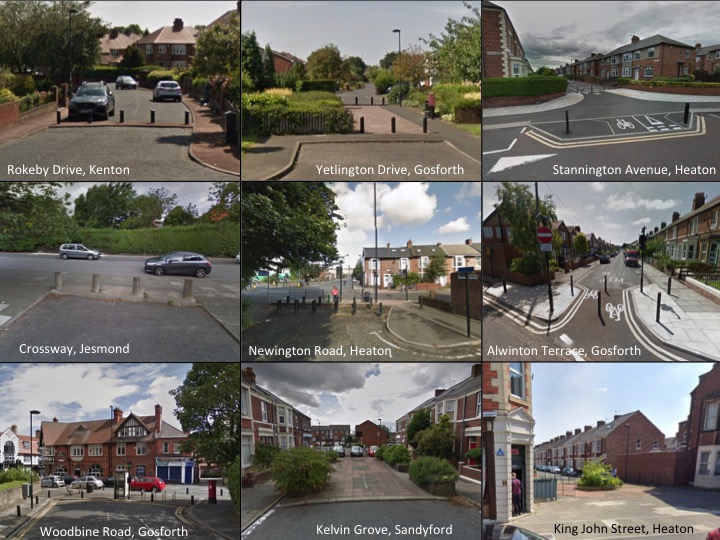
The benefit of the consultation approach, of course, is that we don’t have to agree on what we think the impact will be, as we will be able to see what actually happens once people have had a chance to adjust to the new layout, and residents can provide feedback on that basis.
We sought clarification from the person who made this comment. Their reasoning is that “If the bridge is closed there will be increased traffic as cars cannot disappear instantly from people’s lives. The traffic would have one less exit point so Audley, Sandringham, Windsor or Balmoral would be used”
There are a number of issues with this statement. ‘Cars not disappearing‘ doesn’t mean people can’t change how they travel for particular journeys, and certainly doesn’t justify the statement ‘increased traffic’. We can all help reduce traffic by ‘leaving our cars at home’ and walking, cycling or taking the bus. It also focuses specifically on just one scenario (residents exiting or entering the estate) without taking into account other types of journey on those streets including from through traffic.
To try to explain this a bit more we’ve sketched out four examples of what might happen to show the likely effect.
Example 1 shows the specific journey type referenced to justify the concern. It involves a car journey starting on Audley Road heading west along Church Avenue. Currently the driver might choose to cross Stoneyhurst Road bridge and turn onto Church Avenue by the Grove. A new possible route would be via Windsor Terrace. The diagram below shows these two options but only the parts of the routes up to the point where they exits onto Church Avenue/Station Road.

Example 1: Exiting by car facing south onto Church Avenue / Station Road
By itself this example does suggest that traffic on Windsor Terrace might increase, but it is worth remembering that while the focus of opponents to the proposals has been east of the bridge, the streets on the west side are also residential and will, in this example, have a corresponding reduction in traffic.
If we measure distance driven in the estate before exiting onto a main road there is actually a reduction of 300m or 37% compared to the current route.
This example assumes the vehicle was parked facing south. If facing north, as shown on the map below, that would be an even greater (~82%, 900m) reduction in distance driven within the estate, and one fewer journey on Windsor Terrace.
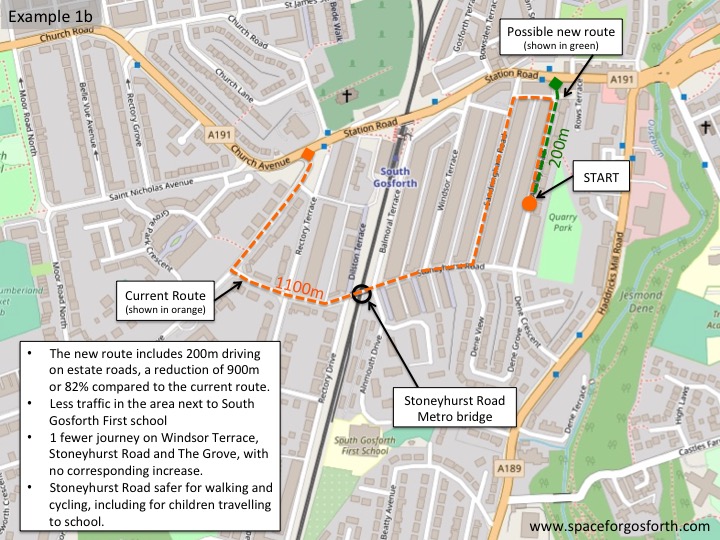
Example 1b: Exiting by car facing north onto Church Avenue / Station Road
Example 2 shows the opposite where someone returning from the east would currently enter the estate by Audley Road, but with the new layout would travel via the Grove. This reduces traffic on the east of the bridge, with a corresponding increase on the west.
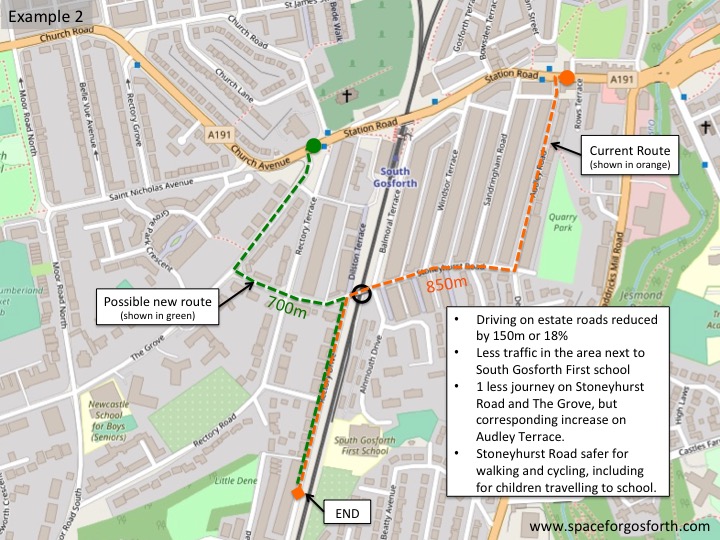
Example 2: Returning home
Again though, the distance travelled in the estate is reduced, in this case by 18%, and in both cases traffic reduces in the area around the bridge itself and the turning into Alnmouth Drive next to South Gosforth First School.
Because of this offsetting, it is unlikely that any one street would see any substantive increase in traffic levels, but actually we’re expecting overall traffic to reduce so we need to look at two further scenarios to see why this is.
Example 3 shows a route that might be taken by someone who doesn’t live on the estate who is using these streets to avoid heavy traffic on the main road. If the change encourages this person to use the main road network instead, which is arguably where they should have been in the first place, then that represents a reduction in traffic on the estate.
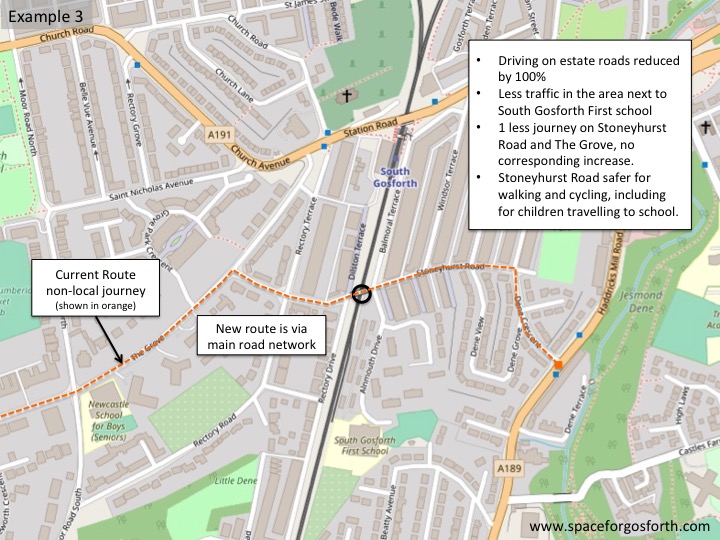
Example 3: Using main roads instead or local streets
Example 4 shows someone who currently drives but as the change reduces traffic levels now feels comfortable cycling and can use the bridge to access off-road / quiet cycle routes leading into the city centre or elsewhere in Newcastle. Again this is a reduction in traffic on estate streets without any corresponding increase on other roads.
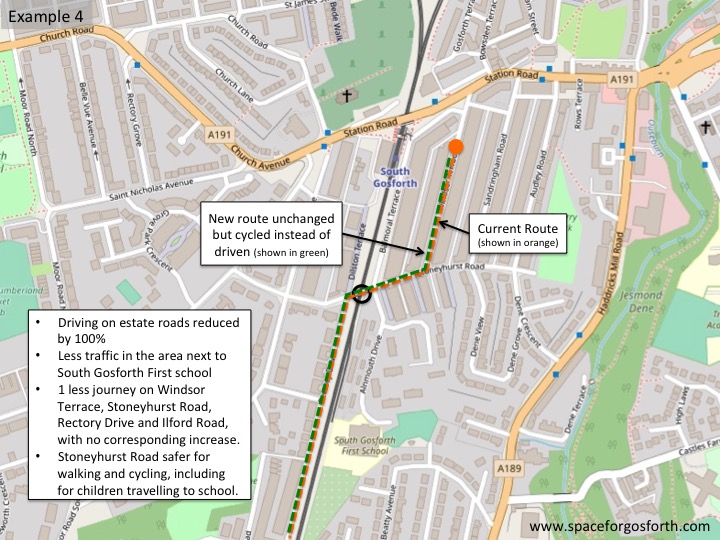
Example 4: Cycling instead of driving
Many people have started cycling during lockdown and this change, and changes like it, are important to enable them to continue as traffic levels rise again.
In our FAQ blog we shared evidence that when similar changes have been made elsewhere people walk and cycle more. We also know from national surveys that many journeys that people currently drive are relatively short and that a substantial proportion of people say themselves that they could just as easily walk, cycle or use public transport for those journeys.
All four of the examples lead to less distance being driven on estate streets, which strongly suggests (as has happened elsewhere) that there will be a reduction in traffic levels on the estate despite claims to the contrary. But as we said previously, the benefit of the approach taken is that you don’t have to take our word for it.
“You get the traffic you build for….Years of research conclude that building more roads generates additional traffic, and reducing the amount of road-space evaporates some traffic”. In this sense traffic behaves more like a gas that evaporates than a liquid that displaces. pic.twitter.com/6E1Ozfxyop
— Robert Burns (@robertburns73) August 5, 2020
Concern 4: Increased cost of local taxi journeys
“potentially the fare will be higher as the taxi sits in a traffic jam in Sandringham Rd caused by the closure of the Stoneyhurst Rd Bridge.”
We demonstrated in our blog East Gosforth – Streets for People that for longer journeys this change will make practically no difference to journey times. Very short, local journeys though may become a little longer if a car is used, although in most cases by no more than a few hundred metres. As above, with less traffic travelling through the estate there’s no reason to believe that queues to exit onto Sandringham Road will be any worse than now.
Generally the intention of low traffic neighbourhoods is to encourage people who can walk or cycle shorter local journeys, up to say 2-3 miles, to do so. Everyone benefits from this. For the person making the journey, they save money and get a bit of exercise while they travel. For everyone else, traffic on local streets is reduced so roads are quieter, less polluted and easier to use for those that do need to use a vehicle.
A big social justice issue related to transport is that a lack of alternatives to driving can mean people on lower incomes are forced to dedicate large parts of their income to paying for a car. Strategic point closures to motor traffic, such as at Stoneyhurst Road bridge, along with cycling safety measures on main roads, create an environment where people feel safe cycling, enabling them to avoid the costs of car ownership and driving.
We also need to be aware in our own thinking to avoid status quo bias, where the status quo is taken as a reference point, and any change from that point is perceived as a loss. This means taking care to consider both positive and negative effects of change and weighing them up as a whole. In general enabling people to walk or cycle helps people save money, potentially equivalent to a 8% pay rise.
Another example of status quo bias is the idea that preventing through traffic from using minor streets displaces traffic onto major roads, whereas it is equally or perhaps more valid to suggest that the absence of point closures is the thing that causes main-road traffic to re-route via minor streets.
Low Traffic Neighbourhoods do not 'displace' through-traffic onto main roads; their absence displaces main road traffic onto residential roads. Other people's neighbourhoods should not be used as a pressure release valve for the fact that there are too many cars on the road.
— Jon Burke MIEMA CEnv (@jonburkeUK) July 14, 2020
Concern 5: Lack of Capacity at Haddricks Mill junction
Although there is evidence to suggest that neighbouring streets won’t see any substantial increase in traffic, we have seen concerns that the new Haddricks Mill junction does not have sufficient capacity if these changes were to lead to increased traffic on Station Road or Haddricks Mill Road.
While we have many, many concerns about the Haddricks Mill junction, lack of vehicle capacity is not one of them. Arguably it will have too much capacity and will induce extra traffic onto surrounding roads contrary to the Council’s own environmental ambitions.
This additional capacity has been created in two ways: through the repositioning of the mini-roundabouts; and through the use of the pedestrian lights to control traffic flow onto the junction to favour busier routes. We have been told by Council engineers that the new design has a similar increased capacity to the much bigger roundabout that was originally proposed. The Council’s news release has further information on this.
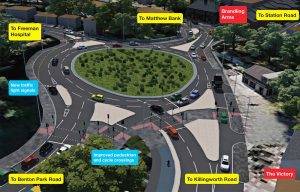
2016 Haddricks Mill proposals, now superseded.
Concern 6: The use of Experimental Traffic Orders is not “democratic”
“in democracies, it is usual to consult first and take advice from the electorate.”
Actually the electorate has been consulted on the need to enable active travel, via both national and local elections. The consultation for the bridges can, and should, take an even wider range of inputs including the views of under 18s who are not entitled to vote at local elections but who are just as much users of local streets as anyone else.
The Conservative government, which is funding these changes and setting the conditions as to what can or cannot be done with the money, has a democratic mandate to implement its manifesto commitments including to “support commuter cycling routes, so that more people can cycle safely to work and more families can go out together.” The Conservative Party said it would “create a new £350 million Cycling Infrastructure Fund with mandatory design standards for new routes.” Our blog on party manifestos for the 2019 General Election is here.
The mandatory standards are now reflected in the Government’s funding conditions and require Councils to take urgent action that will be effective to enable people to walk and cycle. So, for example, a suggestion we received to implement “yellow lines around the school and on the bridge and a leaflet campaign to ask parents to use cars less & act with consideration” would not be funded, unless part of a wider scheme because by itself it would not comply with the mandated standards.
Local political parties also made manifesto commitments supporting active travel, and the Council itself has consulted on its proposals for air quality, climate change both of which require a reduction in vehicle emissions, and has specifically sought input from residents on how to enable more walking and cycling.
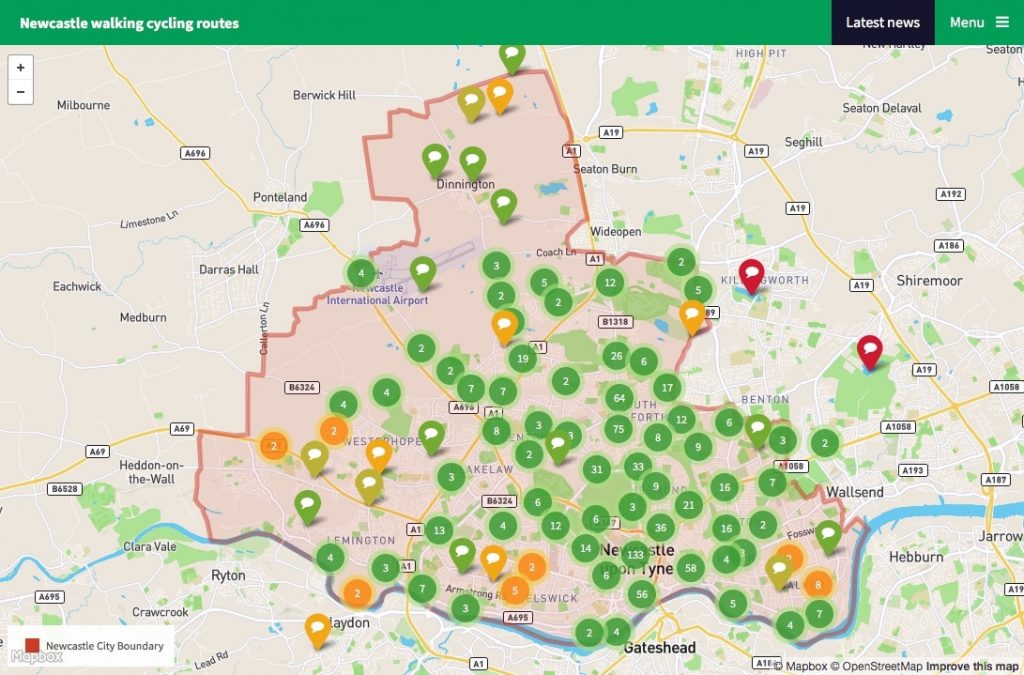
Residents’ comments made in response to the Council’s consultation on walking and cycling
The purpose of consultation on specific schemes is slightly different. The Council already has a democratic mandate to improve road safety and air quality and enable more people to walk and cycle, and is entitled to put forward proposals that it believes will be effective in doing so.
In this case, the Council is using an experimental traffic order, which allows for changes to be put in place using temporary materials so people can see and experience, and so better understand the impact of the change before commenting. Many of the concerns mentioned as reasons to stop the bridge closure such as air quality, traffic queues or environmental impact would actually be better addressed by allowing the closure to go ahead.
While the Council has had to use this approach due to Government funding conditions stating work must start quickly, it is neither new or unusual. Emergency legislation due to Covid-19 only adjusted how Council’s need to advertise changes and not the process itself.
We set out in our FAQ (question 1) why we think this approach is likely to lead to a more informed debate and therefore a better outcome than holding a full consultation in advance. This should be the case even if you believe the changes will (despite all evidence to the contrary) lead to increased traffic, danger or pollution. As it stands the Council would dismiss those concerns as not being supported by evidence, whereas neither the Council nor opponents of the closure can dismiss what actually happens. As above, and in line with available evidence, our expectation is that this change will lead to quieter, safer local streets.
Priorities
More importantly, this change is about health, to enable more people to walk or cycle safely and to avoid crowding on public transport. An estimated 84,000 people die each year in England and Wales due to inactivity and 40,000 in the UK die due to air pollution. Children, who only a generation ago would have enjoyed a substantial amount of freedom are now driven even short journeys because of the danger from other vehicles. The NHS advises that “As you get older, it becomes even more important to remain active if you want to stay healthy and maintain your independence.” Walking and cycling are amongst the most effective ways of achieving this. Many studies have shown the significant health benefits from enabling people to walk or cycle more, as well as a potential £17bn saving to the NHS.
While the changes proposed won’t achieve all of these benfits by themselves, they are a start. We understand there will be opposition to any change, but we hope people will keep an open mind and consider the potential benefits, as well as any downsides, when evaluating the proposals and providing feedback.
The Council’s feedback website for all five bridges that will be closed to motor traffic is here. Please do click on the link and let the Council know what you think of the proposals.
| You can comment and provide feedback on the Council’s proposals on the Council’s Commonplace web site. The web address is https://safenewcastlebridges.commonplace.is |

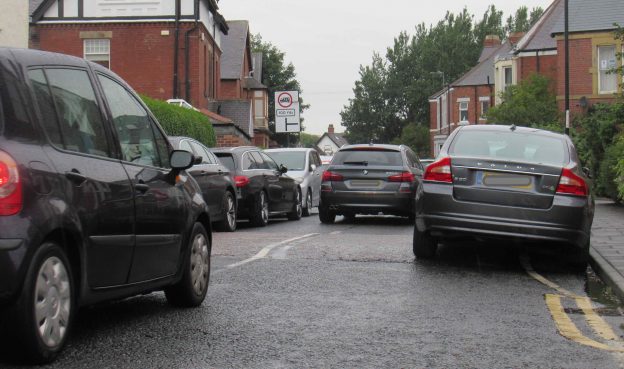
Are you wired up right Professor?
1a. “By itself this example does suggest that traffic on Windsor Terrace might increase, but it is worth remembering that while the focus of opponents to the proposals has been east of the bridge, the streets on the west side are also residential and will, in this example, have a corresponding reduction in traffic” QED
1b. “This example assumes the vehicle was parked facing south. If facing north, as shown on the map below, that would be an even greater (~82%, 900m) reduction in distance driven within the estate, and one fewer journey on Windsor Terrace.” No one in their right mind would bother heading for Stoneyhurst bridge from a North facing start on Audley in order to get to Station Road. I could go on and on as you do……
Hi Gareth, thanks for the comment.
Yes, I agree the sensible thing to do in those circumstances would be, as you say, to exit directly onto Station Road. The junctions onto Station Road are no more or less dangerous than other local similar junctions. This is pretty much what we said in answer to the first concern.
We wanted to include the scenario only because it is a natural consequence of that first concern, and because the same person who said exiting onto Station Road was not safe also said that the change would lead to more traffic. As the example suggests it is very unlikely that both would be true.
Even without example 1b though, the consistent result from all of the examples is less traffic on estate roads, and less traffic near Stoneyhurst Road bridge. If you think this is wrong though please feel free to set out why you think this is.
Thanks at least for conceding 1b. The consistent result is of course that “there will be less traffic near Stoneyhurst Bridge” and that is precisely where we begin to become unstuck. Of course there will be” in general less traffic on estate roads” but these plans put more miles and more stress on people who live on their “wrong” side of the bridge – the bridge which encouraged them to invest heavily in living here in the first place. Once you’ve got rid of these troublesome neighbours and only the “right” sided people live here, or the able-bodied, active ones, your plan should work. It is elitist, ableist and not thoughtful or considerate enough. You should instead be offering inclusive suggestions that would still dissuade/calm through vehicle traffic and offer better opportunities for cycling without hammering the people who live here.
It’s good that we agree there will most likely be less traffic on estate roads. The trial will let us see if this also happens in practice. This will benefit all residents, including those that need to drive, those that do not own a car, people who would normally not choose to cycle due to traffic or those using accessible cycles, powered wheelchairs or mobility scooters, people with respiratory complaints and those that might be more at risk from traffic.
For those that do drive, our analysis also showed that except for very short journeys no one would have to drive much further. Arguably driving a bit further for fewer journeys, and to have permanently quieter streets, is a trade off many people would want though.
We’re happy to consider other options if you wish to suggest some, although the option proposed is one that has been used widely already in Newcastle and around the UK without any issues. We have heard concerns in the past about speed bumps being an issue for certain people.
I’m a delivery driver, now that stoneyhurst Bridge is closed it is now exceptionally difficult to get to South Gosforth school, cars are parked either side of the roads surrounding, sometimes I’m having to make quite frankly dangerous manoeuvers to get my wagon round. I’m not sure how a fire engine would get down there either, in my experience the area was busy at peak times, like everywhere.
Hi Dan, Thanks for sharing your experience. Many of the residents we have spoken to and parents of children attending South Gosforth school are really appreciating the much quieter streets and overall it is pretty clear the area is safer for children, especially walking to and from school.
For larger delivery vehicles the change shouldn’t have made a difference as there was already a 7.5T weight limit on the bridge.
For your wagon though, if you contact the Council with specifics they may be able to do something to amend parking arrangements so you are less obstructed at junctions as the roads themselves are plenty wide enough.
The fire service will have been consulted by the Council prior to closure and I’m sure they would have expressed concerns had they had any, but it’s certainly no worse for vehicle access than other long-standing traffic calmed estates around Newcastle.
Hello SPACE,
I am just wondering how many of you live to the east of the Stoneyhurst Rd bridge.
My mother lives there and is no longer able to bike. She uses a walking frame now. She has to use a taxi if she want sto leave the house. This now costs more money and to go to Gosforth or the town is now very difficult as the taxi has now traffic lights.
My mother has had trouble getting food deliveries as vans can no longer cross the bridge.
Have you any advice for her?
I visit her by bike but that does not help her go out.
Re biking, I have found it more dangerous recently which has been such a disappointment as I was promised a sort of a paradise once Stoneyhurst bridge was closed.
Perhaps you can give us both some advice?
I’ll look forward to hearing from you.
Mary
Hi Mary,
Thank you for your comment.
The Council’s statement was that “By restricting traffic in these areas [The Council] believe it will help create safer, cleaner and greener neighbourhoods and encourage more walking and cycling.” You may believe this is ‘a sort of paradise’ but I don’t believe those words were used anywhere.
Typically changes will take a few months to bed in hence the need for a 6 month minimum trial period.
We have had feedback from people living on both sides of the bridge that the streets are already feeling quieter, but if you can give some more details about where and why you found cycling more dangerous that might be something we can look at.
Most supermarket delivery vans should be able to use any of the roads east of the bridge, and in fact I have seen them doing so. Larger vehicles shouldn’t have been using the bridge anyway due to the wait restriction.
I will admit that I was deeply sceptical about the plan to close Stoneyhurst Bridge, as I expected huge congestion nearby once it came into force, especially at school drop off and pick up times. In fact it would appear to have been a big success. Far more children and parents cycling and walking to Gosforth First School. Also greatly reduced traffic on Ilford Road, Lodore Road, Newlands Road which I did not expect.
One potential problem area remains Rectory Road, which seems to be getting more rat running, often by large south-bound vehicles around 8 am. This overspills into Moor Road South. This might reflect current slow traffic at Haddricks Mill and Gosforth High Street.
The parental SUV parking chaos continues near Newcastle School for Boys of course, but that is a separate long-term issue.
It is miserable trying to get anywhere with Stoneyhurst closed . Yesterday we had a guy coming out to quote for room in roof and underfloor insulation (green homes grant). He had parked the other side of Stoneyhurst as that’s where his satnav took him and he didn’t have time to reroute. Then he needed ladders from his van to look into my loft space. I had to borrow ladders from my neighbour. It was farcical.
Today my sons teacher had to park on Stoneyhurst as she couldn’t get down balmoral. A couple of cars were in a stand off about who should reverse to let the other pass. Ended up having to get the police out – they reversed the car for the driver who was too nervous to do it. It’s offensive that anyone who objects to the closure is seen as anti-green. I certainly am not but it’s depressing -honestly.
Hi Nicola,
Thanks for sharing this.
Certainly if you were prioritising environmental objectives over other considerations then there’s a really good case to keep the bridges closed to vehicle traffic, as experience from practically everywhere similar schemes have been implemented is that these changes reduce driving and people walk and cycle more as a result. If you think there’s a “green” case for opening the bridges though please say.
I did walk along Stoneyhurst Road the day before your comment at about 3pm when parents were picking up children but even then there were very few moving vehicles and Balmoral was completely clear so hopefully these are one-offs and fairly easily resolved. I walked along Balmoral again today and there were multiple places people could pass if needed.
In terms of the issues you mention, are they not caused by multiple factors?
For the tradesman it sounds like it was a combination of bridge and an out-of-date Satnav. The latter could be fixed quite easily surely? I’m also guessing that it would actually have been quicker if he had driven around given the time it would have taken to borrow some ladders.
I’m guessing your other anecdote was at least part caused by snow, and if someone isn’t happy reversing in those conditions then maybe they shouldn’t have been driving in the first place that day? The situation could equally have happened if the bridge was open to traffic, although possibly fewer people are travelling now because of Covid restrictions meaning there are fewer places to pass.